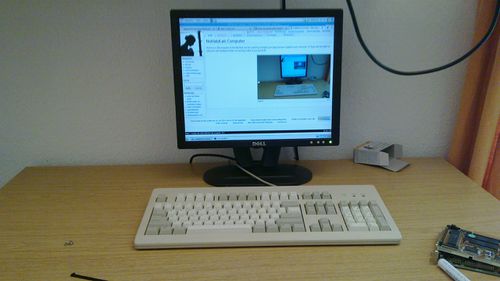Noklab/Lab Computer: Unterschied zwischen den Versionen
Keine Bearbeitungszusammenfassung |
Keine Bearbeitungszusammenfassung |
||
| Zeile 1: | Zeile 1: | ||
[[File:Nase_Labpc.jpg|500px|thumb|Lab PC]] | [[File:Nase_Labpc.jpg|500px|thumb|Lab PC]] | ||
== Lab01 == | |||
There is a very old computer in the lab that can be used if you forgot your laptop power supply or just came by. Or if you do not want to risk your own hardware while connecting a device you just built. | There is a very old computer in the lab that can be used if you forgot your laptop power supply or just came by. Or if you do not want to risk your own hardware while connecting a device you just built. | ||
Version vom 19. März 2015, 11:46 Uhr

Lab01
There is a very old computer in the lab that can be used if you forgot your laptop power supply or just came by. Or if you do not want to risk your own hardware while connecting a device you just built.
Turning It On
Geht gerad nicht, da Labrechner 2.0 und Autologin noch nicht eingerichtet, bzw. anderes PW als der alte Rechner.
You have to flip the manual power switch on the power supply. The PC will then turn on automatically. The system is configured for autologin as penny.
Turning It Off
Just shut down the system as usual, then switch off the switch on the power supply.
Printing
see Noklab/Printer
Joining the MUC
There is a dedicated XMPP account for penny, just start pidgin.
Turning It On - Remotely
If you want to start penny remotely, you need a special key save it to ~/.ssh/remote_dropbear_id_rsa:
-----BEGIN RSA PRIVATE KEY----- MIICYwIBAAKBgndy8y+sy1TRHdKqKGOGx8NXjC6lBYxx98w6vwUdWbZxGEo/x++q bSHc362CCufaoJlsDcEqBB5lK+2f4wGa9YEbqtZNsnPfvEVFB9Lbx45ZDlt/3rqX hkN38W0un5FZcx3Ppz/Ro+vrJaJNt23x7nwq1qJJr9RYvvqIpx9LgcLy+00CAwEA AQKBggeMJtuTUoG4eObvw3+Oa57nMD9eQ/x80wh/icRb92g0uzEt2IdHQIAMQcHn 3qKJyO4IytGywvHcuKraGHDohqyyqalHdYUZc0/Gz24RUaJHoEv7gLYaep0f1ToG yjTQJknZWjwMERDAumBI2uOPY00uPFjVZwAQh8BM+jRLMt7xewECQgCgXYA3mO5i 9HCBCCVh994vBGGa/S30jaxS7uuEu3z+CoRTHUNjFc3dbdB15Ypy+5XQZLjlIMEn NY7pOW1aTG9rQQJCAL6u43BPqYyswA0S/x3WshrGOP15Vf1NibJI2RFW68hZHLXp Ktajrm3qOmq93LQIfi4Mfs/tbHQMJemWpoFXdUkNAkFJy30LGJbqdm2nEuaQ9I0L ucpolgUlumQILeW3SMe154UI8jhmSkxXjwcUmbJiQx+nrBHhbncz4dOHw2Ns4CuN gQJBFix2LEhHOiGYj6ym2AxwV6a3V9p1Qmhy27WW8GpALuMV8J11qtIL5aI4OtNr R9A5BBfV404Dr5b+DaTEJgRKkj0CQVcY5vMJIcfBrljms+xX0jO0BPtNiQqIJobl ZJQvMMXosXRHqfzqe4/wu/5radbbGSxvnYm/6LegyB67lTAA/gV7 -----END RSA PRIVATE KEY-----
And a new knwon_host file (.ssh/.ssh/known_hosts.initramfs):
|1|vMJrq/P0HbVhbVWENsuvF4w/Dgk=|//fdEvPyUeaYVNm2sAXklHxttC4= ssh-rsa AAAAB3NzaC1yc2EAAAADAQABAAAAglJE2x6GOphU0FMDwDnpllMyhL4gj14DE2YzQfOIS5aMfvl3cEh7p+CEW+MWhRpf7bmJ3tXT8E7dvrDGw7Ag8IXnlkAKh2xcpkudEcT6gvK5pxUPcD1hObodVX2dT6KSHBbadd2FkGJtMkabEnNpN0qDA1QKZHfsVbh5A3+0OI8awL8=
Now you have to run following command:
ssh -o "UserKnownHostsFile=~/.ssh/known_hosts.initramfs" -i ~/.ssh/remote_dropbear_id_rsa root@10.23.42.125 "echo -ne "PASSPHRASE" > /lib/cryptsetup/passfifo"
Or modify the .ssh/config:
Host penny-login
Hostname 10.23.42.125
User root
IdentityFile /home/hefee/.ssh/remote_dropbear_id_rsa
UserKnownHostsFile /home/hefee/.ssh/known_hosts.initramfs
Afterwards the folloing command:
ssh penny-login "echo -ne "PASSPHRASE" > /lib/cryptsetup/passfifo"
lab02
ipv4:10.23.42.117
-----BEGIN RSA PRIVATE KEY----- MIICZgIBAAKBgwCH6IDhYjWTNOy4nUb/x7/P249RQsoFGdVuc16n5zxDtiV5Qw1J rZYw3fax1U/FtA5/lU35URu6208phcPfYPQzJv6nZegfcR9yXc40vFWgij3Qq8sE ZIlZ2stzWbyYu55fIikHz2V4qIuxEbhcisrOWT2MlItq6Z+saTl83+Q29DKrAgMB AAECgYICIb+DyYqVmIruCmmGsZdsp0EEQUvx8InMhbrCX3ouhbjowgh/U127vn+U IohxzXU8wxbKBl+s+quvNw3vfxHVi40ujOjgWeP+QNmw5X1jXHt7PHvuOZmY19s6 ThOWeCAvvFUU7m/8HP57vBUJeVfNhFMqb0+Xe/G7dNSb5ZojSTpBAkIAsCxS9//Y lZ/2IK8RZYzTYBYqQJLxygjMQ7ShF3lCeRDGma+b3fPrtRtHd0axF7BbGpZTHvGL UNQvMGRqxU3bIwkCQgDFfYqdIeUnK9hAguImpqwyd8Z6066O5R10R9wImRHime7H ztukxD6ujyytRhEp8CPRlwIqCOxy2pOrR7hZdbUREwJCAK5bz+m+/z5myJPkcJVO 4Uyx4zNxu3e3aWKA/QZcbtufLM+iK+NprBjcXMjB4DePxTr1GGMBsF5ZAjMkzz9j JMTxAkIAlAybH1TLnuPlh+cWdnc4W9Uiu+14zLLBs+wy7Vci60cOlEdkrU5Y1y+K BJOkRlY54+NawfxSlX96eEqZzqbJCHUCQQsgX5OUbELlWtoQHAWwrmamVknooRag Bn7qp/lBBbYPgjOXkYScrVMnOI8dEmCQg6DpRkb00FKTibFyzcLB535M -----END RSA PRIVATE KEY-----
|1|+mJbwJfXefv6exw2f8ljEKsfft8=|pgSI7M/S8+jtnZf9DG0wQh2Gw68= ssh-rsa AAAAB3NzaC1yc2EAAAADAQABAAAAgn5EXI5ulOZs/4WvTotVL4LycHeLnvUpkOm0VyW/ydbm9e44iuiqdkUT9IZMVz3LM2au/DBLKQu4USzBAEnsu3+U/Xn9Bt1reA3qlUwFxEcLtKQ6sc9DPbZEGG9BfNptquht3hZ9b+cHra9DmK+awidurra3PaB3BONNx1DcqjfUf88=
Badblock
Badblock is the heavily decorated laptoplocated somewhere in the space. It has a Core2 Duo CPU, some ram (2G I think) and lots of HD space (500G). It can be used as an emergency-laptop if you forgot your own or your battery is dying, or as a remote desktop connected to the beamer for multiple people to work on. Pixelflut is installed, too.